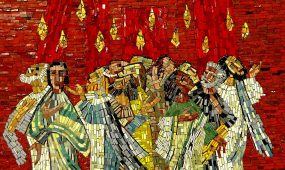Tough Questions: Why are Matthew's and Luke’s accounts of Jesus’ birth so different?
Dates & Seasons
“An author’s silence about an event need not signify that it did not happen. It is therefore judicious to reconcile the two gospel accounts of Jesus’ birth by recognising that neither author detailed every aspect of the narrative,” says The Rev’d Charlie Lacey

We are so used to seeing the nativity depicted in the form of cards, paintings, models and plays that we might be forgiven for thinking that every facet of this well-known scene is described by all four gospel writers. In truth, only Matthew and Luke describe the birth of Christ and their accounts are far from identical. For example, Matthew states that an angel appeared to Joseph in a dream, whereas Luke describes the angel Gabriel visiting Mary in person. Both Matthew and Luke recount a group of people visiting the infant Jesus, however, for Matthew it is a group of Magi and for Luke a group of shepherds. Matthew chronicles the family’s escape to Egypt, whilst Luke makes no mention of their sojourn in Egypt. What are we to make of these differences?
Firstly, it is important to recognise that “difference” is not the same thing as “contradiction”. If you were to read about an event in two different newspapers, you would not expect the accounts to be identical, since each reporter would have his or her own perspective. Moreover, by reading two reports on the same event, you would most likely get a much fuller picture of what occurred. Admittedly, a comparison of the accounts of the birth of Christ in Matthew and Luke does present us with some conundrums, but overall, they complement each other in the same way that two newspaper articles might do.
Most of the differences can be attributed to the details that each writer chose to include or omit. For example, it is perfectly reasonable to surmise that both Joseph and Mary received some kind of angelic visitation.
Perhaps the most difficult details to reconcile are the fact that Matthew tells us that the holy family fled to Egypt, whilst Luke seemingly has them returning to Nazareth immediately after Jesus is presented in the temple (which would have taken place when he was forty days old). There are two possible explanations that negate the need to hypothesise that one or both authors “adapted’ the story for rhetorical or theological reasons.
Advertisement
Firstly, it could be that Jesus was presented in the temple after the Magi’s visit in Matthew 2. If the family returned to Nazareth immediately after this event, it would mean that they fled to Egypt from Nazareth and not Bethlehem, which is plausible since Herod’s jurisdiction included Nazareth. If this is the case, Matthew 2.13 would be understood as follows, “When they [the magi] had gone, [insert Luke’s account of the visit to the temple and return to Nazareth], an angel of the Lord appeared to Joseph in a dream.”
The second possibility, and in my view the more likely, is that the family’s flight to Egypt took place after Jesus was presented in the temple and before they returned to Nazareth. In this case, Luke 2.39 would read as follows, “When Joseph and Mary had done everything required of the Law of the Lord [insert the family’s return to Bethlehem, the magi’s visit and the flight to Egypt], they returned to Galilee to their own town of Nazareth.”
Advertisement
An author’s silence about an event need not signify that it did not happen. It is therefore judicious to reconcile the two gospel accounts of Jesus’ birth by recognising that neither author detailed every aspect of the narrative.
The foregoing observations draw our attention to the differences between the two accounts, but of far more interest are the similarities. Matthew and Luke both assert that Mary was a virgin when she conceived and that an angel announced that her son would be the Messiah. Both authors affirm that Mary and Joseph were engaged to be married and that Jesus was born in Bethlehem. And, in both gospels, Jesus’ family end up in Nazareth. Most importantly, the clear message of both evangelists (and indeed all four gospel writers), is that God has entered the world in the person of Jesus Christ to bring salvation to his people.
As we enter the season of Advent, let us enjoy this story with all its layers and complexities and give thanks for the awesome events that paved the way for us to be reconciled to God through his son Jesus.
John 3.16
“For God so loved the world that he gave his one and only Son, that whoever believes in him shall not perish but have eternal life.”
First published on the St Andrew’s, Springfield website on 3 December 2023.





